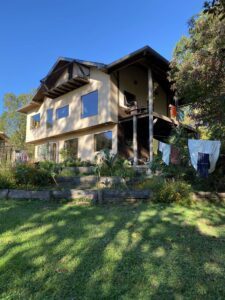It’s a warm spring day full of new and green growing life, and the sun is pumping clean energy into the off-grid house where I live at Earthaven Ecovillage.
Earthaven was founded in 1994 by 12 people seeking a better way of living than the typical urban, suburban or rural modern lifestyles which are often designed in ways that disconnect humans from each other and the natural world.
The founders of Earthaven shared an environmental ethos and decided early on that they wanted this community to be “a living laboratory for a sustainable human future” that would not only teach why sustainability is important, but show how we can live in good relationship with the land, our food, housing, and each other.
There are many types of innovative living situations here. Single-family homes, co-housing units, microhuts, tiny houses, and other light-on-the-land dwellings make up 12 different neighborhoods and a village center.
With vibrant creeks, several springs, a few ponds, and significant rainfall, this is a place with an abundance of water moving through it.

No power lines come into the community of approximately 115 people, so Earthaven has had to figure out how to get much of its electricity, hot water, and heat from the sun, streams and forest. The off-grid community is powered by two micro-hydro systems and a multitude of home and neighborhood-scale photovoltaic (PV) systems.
There is a commitment to intelligently designed and small-space living and village-style density to minimize our footprints and share resources commonly. The average home here is much smaller than the American average, and many residents share kitchens and bath houses.
As the village matures, so does the housing. Innovation guides the builders and renewable-energy specialists who are actively building in the community and have been using Earthaven as a learning opportunity for more than two decades.
In August 2020, I moved with my family to Earthaven into the Love House, which was built in 2008 by Brian Love. My home is powered by the sun, heats water with solar collectors and the wood cookstove, and provides delicious spring water flowing from the taps. The neighborhood microgrid (a 7-kW PV system) powers the barn, our water system, the Love House, and two small cabins.
The feature that I’m most impressed by is the passive-solar design. On a sunny winter day, even if the temperature is in the 30s, we don’t need a fire to stay warm. The sun coming in through the massive windows with high Solar Heat Gain Coefficients soaks into the concrete thermal mass floor and countertops during the day, then slowly radiates out at night. So even on a morning when it’s 28 degrees outside, it will be 65 degrees inside with no supplemental heat other than the sun.
Passive solar works, people! I’ve been working in the field of green building for more than 20 years, and I learned early on about passive solar. I hadn’t had a chance to live in a house with true passive solar until now, and wow, it is great.
Our only supplemental heat is a wood cookstove, and I only burned two-thirds of a cord of wood this past winter. The house where we previously lived in Candler had baseboard heat, resulting in winter electricity bills of $250 a month, and I burned three cords of wood. Passive solar design and good insulation make such a difference.
The element of this house that I’m most excited to show first-time visitors is how all the wood used to build the house came from the land right outside. Where a secondary forest once stood is now a small-scale integrated farm. Those trees were harvested on site, milled and dried at a nearby lumber yard, then returned to build the house.
The wood hero of the house is tulip poplar. It is such a beautiful wood and it makes up the 2×6 walls, cabinets, and ceilings upstairs. In a bioregion with abundant tulip poplar, it’s a wise choice for using local materials. Oak and cherry were used for the flooring, and maple and walnut for the banisters.
The layout of the 1,200-square-foot house is conducive for cooking and visiting with friends and family, while the garden right outside the door grows some of our favorite vegetables, flowers and herbs.
Living in an off-grid home has encouraged us to make two minor adjustments.
The first is related to access to hot water. In the winter on a cloudy day, the solar hot water collectors don’t get warm enough. To get enough hot water, I make a fire in the early morning so that the heat can exchange into the hot water tank to be ready for an evening bath or shower.
The second small inconvenience is not having a clothes dryer, so all the laundry gets dried on a clothesline or rack. Watching the weather for sunshine and choosing laundry day is just another way we live in closer relationship with the sun and seasonal cycles.
The pandemic brought many changes to each of our lives and to society as a whole. I feel lucky and blessed to be living at Earthaven Ecovillage in this super eco-groovy house, and I hope that you too have found ways to feel more at home, to improve your living situation, and grow closer to the cycles of nature.
Sam Ruark is the executive director of Green Built Alliance. He has spent two decades working in the field of sustainability with local governments, small businesses and nonprofits. Connect with Sam at Sam@greenbuilt.org.
You can also view this article as it was originally published on page 46 of the 2021-22 edition of the directory.


